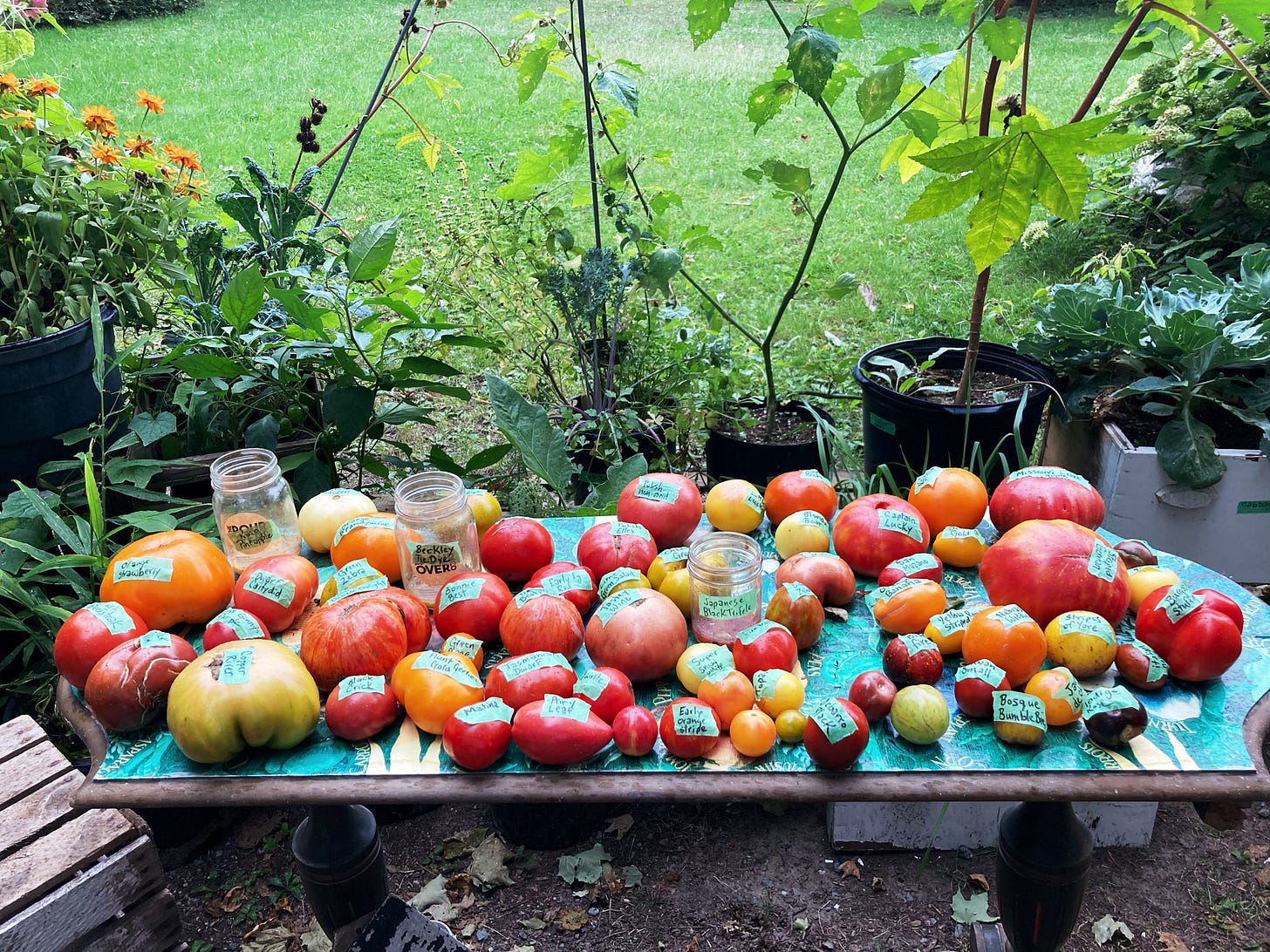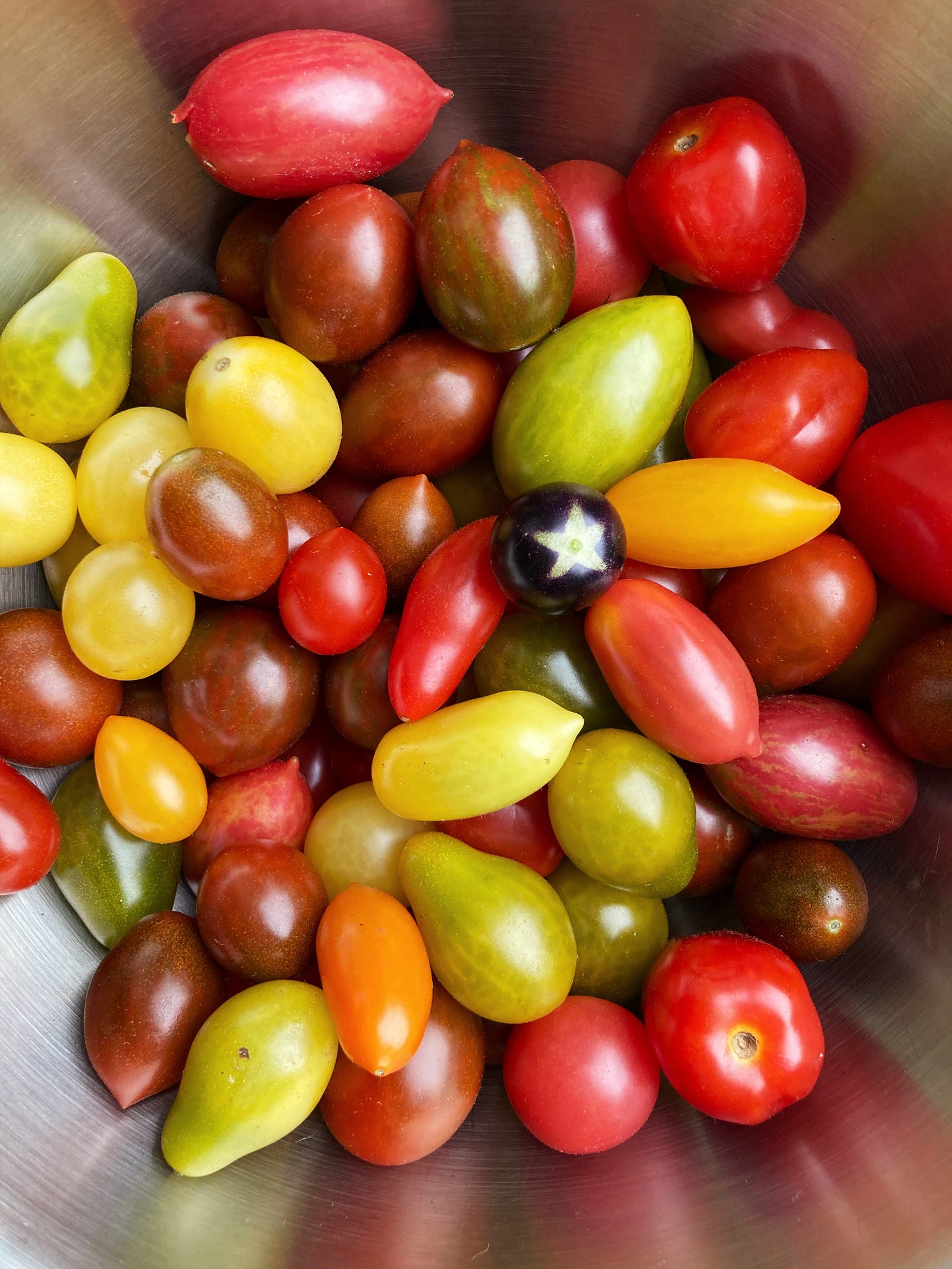A while ago, J. and I visited a farm stand in Prince Edward County that profoundly altered my relationship to produce. More accurately, it made my ignorance about agriculture crystal clear, like the right combination of lenses during an eye exam that demonstrates the extent of your myopia. The farm was called Vickie’s Veggies—known in the County for the 100+ varieties of heirloom tomatoes they produce, and a market that runs on the honor system. On a table outside, they’d displayed and labeled a selection of their cultivars, with names like Captain Lucky and Don’s Double Delight. We gawked at them like children at the zoo, encountering evidence of the wild for the first time.

For me, a lifelong city dweller for whom variety still meant getting three colours of grape tomatoes in the same plastic pint, it was a shock to the system. I couldn’t, and still can’t, understand why our grocery stores are so reductive; why tomatoes must be homogenized into the same perfect, blemish-less shape. It makes sense to me, in the “intuitive rules of the universe” kind of way, that the more we optimize for appearance and longevity, the less we optimize for taste*. Or maybe I think that because I tried a tomato from the farm, and I can never bring myself to buy the sad, still-pink Romas from the grocery store again.
I had never eaten as many tomatoes as I did this summer. They are the perfect hot-weather food: served sliced on sourdough bread, with a generous layer of mayo and some flaky salt; served grated on sourdough that you’ve rubbed with a raw garlic clove, borrowing from the Spanish; served in wedges with feta, basil and a balsamic reduction. I’m not telling you anything you didn’t already know, but to me, it was a revelation—the ideal form of an ingredient on display. Each time, I tasted something new: the stemmy top notes of the firmer flesh, the succulence of fruit ripened by the sun, the back-of-the-throat, near-meaty savoriness of MSG. I never wanted tomato season to end. But just like summer, the produce of the season is made even better by our anticipation of it. We tide ourselves over with the stews and soups and sauces, until the days get warm again.
But having a keepsake around doesn’t hurt, right? Yesterday, I saw the last of this season’s heirloom tomatoes at a fruit market, and saw my chance to prolong summer in my own heart: by making a batch of tomato confit.

(Look at that little purple one’s tanline!)
Tomato confit, based on the traditional French method of cooking things in fat to preserve them—confit is from confire, to preserve, to pickle—is a great way to use up a large quantity of tomatoes without turning them into a sauce. By roasting them in oil for an extended period of time, you’re trading in the fresh and tart aspects of a tomato for a rich, savory depth. It’s like eating jewels that fall apart in your mouth—a luxurious experience that requires little effort except heat and a few glugs of olive oil. Put the tomato confit in the fridge, and you can enjoy it for weeks to come.
I plan to use it on pasta and serve it on toast with feta and maybe just spoon each tomato directly into my mouth, who’s to say. But if I’m honest, the best part will be seeing the jar of little wrinkled tomatoes in the fridge, knowing that I’ve cheated time, for just a little while.
*After writing this, I looked it up. Here’s what the Wiki on heirloom tomatoes has to say:
Many heirloom tomatoes are sweeter and lack a genetic mutation that gives tomatoes a uniform red color at the cost of the fruit's taste. Varieties bearing this mutation, which have been favored by industry since the 1940s, feature fruits with lower levels of carotenoids and a decreased ability to make sugar within the fruit.
The more you know. 🌈💫
Recipe notes:

I’d stumbled upon this old post on Instagram, then compared a few recipes to make my own. The beauty of tomato confit is its absolute lack of rigidity; you can keep it bare bones, or you can doctor it up with herbs and spices. I threw in shallots, garlic, sprigs of wilted oregano, and a couple of ancho chiles I had left over from making mole. You can also do onions, leeks, thyme, or even add other vegetables.
The temperature is equally forgiving: Judy Kim roasted it at 375° for 60 min, while I did 250° for 3.5 hours. Adjust based on your love of crispy bits.
Other takes on tomato confit:
• Martha Stewart, adapting Thomas Keller, the simplest version you can make.
• Melissa Clark’s version, which features rosemary and a little chili pepper for a kick.
• Why not bake it into a galette situation? Tomato tart à la Provençal, from Perfectly Provence.
What recipes will you carry into winter? I could use all the help I can get.
Until next week,
Tracy
